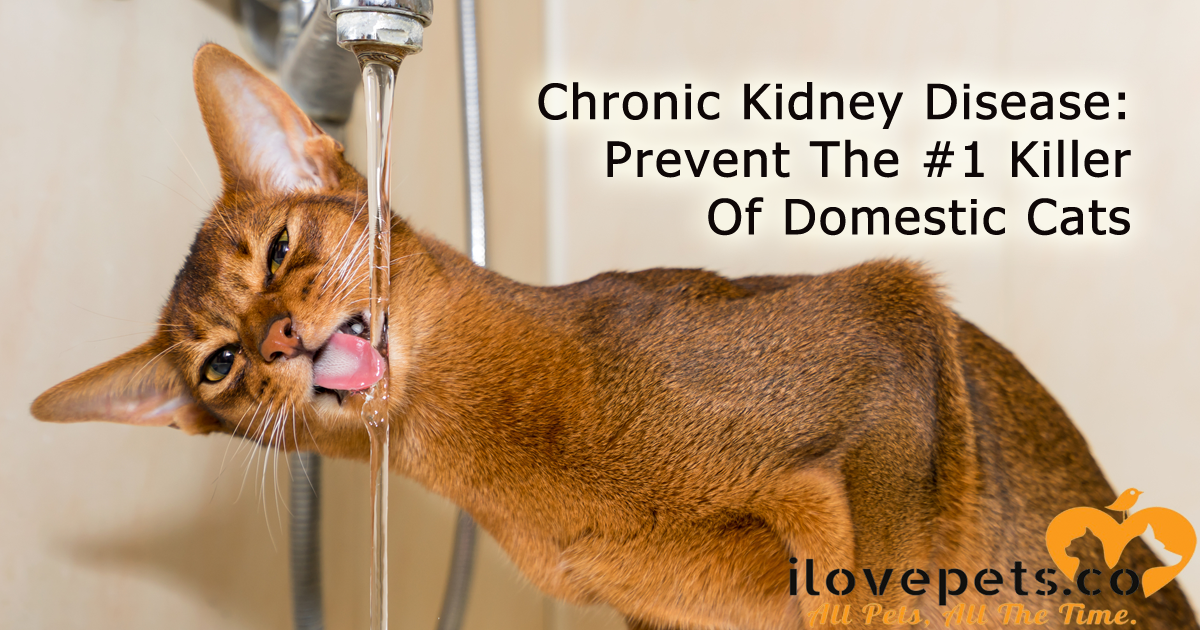
When you’re a cat lover, there are three words that you never want to hear from your vet. Chronic Kidney Disease.
Most common in seniors, some vets have accepted that 1 in 3 cats will be diagnosed with Chronic Kidney Disease (CKD) in their lifetime. A 2016 study found that over 60% of senior cats (over age seven) will develop some form of kidney disease, with prevalence in geriatric cats (over age 15) skyrocketing up to 80%.
Fortunately, CKD can be prevented and may be managed for years with at-home treatment. Supporting your cat’s kidney health is essential to helping them live as long as possible.
Why Cats Get Chronic Kidney Disease
While kidney disease is incredibly common in today’s domestic cat, it’s rare in cats that live in the wild. There are several factors that are contributing to this epidemic:
- Many diseases including feline leukemia, diabetes, and F I V seem to increase a cat’s risk of developing CKD.
- Frequent (yearly) vaccination has been linked to CKD. However, the diseases that vaccines prevent are even more deadly, so you should not forgo vaccinating altogether, even if your cat never goes outside. Talk to your veterinarian about titer testing to avoid over-vaccinating for diseases for which your cat has already developed immunity.
- Dental disease is extremely common, affecting over 50 to 90% of cats over age four. Bacteria travels from the cat’s mouth through their bloodstream, eventually causing kidney inflammation.
- The popularity and convenience of dry cat foods may be responsible for widespread CKD – a low-moisture diet makes it difficult for the kidneys to effectively filter out wastes.
How To Prevent Chronic Kidney Disease
A diet that consists solely of dry cat food puts your cat’s kidney health at risk. Cats will typically not drink enough water to make up for the low moisture content. But many cats have imprinted on it from a young age and will not eat anything else. You may have to experiment with different types of canned food to find a formula that your cat will actually eat. Warm food releases stronger aromas that your cat may find enticing. If you don’t want to stick cat food in your microwave for a few seconds, try pouring a bit of hot water or broth over it.
Cats instinctively seek outrushing water, rather than standing water, as in the wild, this indicates freshness. A cat water fountain can encourage your cat to drink more water. You can also add low-sodium chicken broth or tuna juice to make water more enticing.
Contrary to popular belief, dry kibble does not clean teeth. The starches break down into sugars in your cat’s mouth, feeding bacteria and contributing to dental disease. Use cat toothpaste to clean your cat’s teeth a few times per week. Meat chunks and raw meaty bones can help keep your cat’s teeth clean, even if you can’t feed a completely raw diet. If your cat won’t eat anything raw, enzymatic dental chew treats like Virbac can support their dental health. Your cat may need yearly dental cleanings to break down caked-on tartar that is not removed by chewing or brushing.
Symptoms Of Chronic Kidney Disease In Cats
In the early stages, most cats do not show any symptoms of CKD. Signs of advanced kidney disease seem to come on suddenly. That’s why it’s so important for senior cats over seven to have vet check-ups twice per year with bloodwork and urinalysis.
Common signs of Chronic Kidney Disease include:
- Lack of appetite
- Vomiting
- Frequent urination
- Bloody or cloudy urine
- Weight loss
- Accidents outside of the litterbox
- Drinking more water than usual
- Dry skin and coat
- Constipation
- Weakness and lethargy
When you have a senior cat, you should never delay a vet visit, even if symptoms seem mild. The sooner you can start your cat on treatments, the longer they can live with CKD.
Caring For A Cat With Kidney Disease
There is no cure for CKD. The symptoms and progression can be managed with medication, and your cat can live for years after the initial diagnosis, particularly if it is caught early.
Your vet may prescribe a special cat food that is low in protein and phosphorus. A cat with CKD will have trouble filtering excess phosphorus through their urine, These diets are controversial – and your cat may refuse to eat them because the low protein content can make them less palatable. Holistic veterinarians and nutritionists recommend a fresh, raw diet, which is naturally high in moisture, and the phosphorus, found in meat, can be balanced with calcium.
When it comes down to it, every cat is different. Some will not eat a raw diet but may adjust to a high moisture canned diet. Some cats will refuse to eat anything other than their favorite dry food, and may need subcutaneous fluids just to keep them from getting dehydrated. Some cats can live for years after diagnosis, while some will progress quickly.
Work with your vet to find a treatment plan to works for your cat, but don’t be afraid to get a second opinion if you don’t feel confident that they can provide the best possible care.
Share This Article And Help Raise Awareness of the dangers of Chronic Kidney Disease (CKD) in Cats: The #1 Killer Of Domestic Cats.






